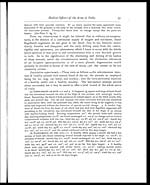Medicine - Institutions > Army health reports and medical documents > Scientific memoirs by medical officers of the Army of India > Part III, 1887 > 7 - On the lately demonstrated blood-contamination and infective disease of the rat and equines in India
(62) Page 56
Download files
Individual page:
Thumbnail gallery: Grid view | List view

56
Scientific Memoirs by
(c)EXPERIMENTS ON THE CAT:—I. A large black healthy male; e.t. 101°; had inocula-
ted at inner surface of thigh a minute clot of rat's blood filled with active organisms:
second day m.t. 98°; was again inoculated with a small clot from another rat just killed,
which contained many monads,—this being done to ensure thorough trial; e.t. 100° nil:
third day m.t. 98°, blood nil, the wounds scarred; e.t. 102°; animal feverish, but eats heartily
and sites of inoculation not inflamed; a few large granule-cells observed in the blood:
fourth day m.t. 98°; nothing abnormal seen in the blood except a few large granule-cells; e.t.
101.6°; nothing abnormal in the blood but some large plasm-particles and a few large
granule-cells: fifth day m.t. 99°, nil, e.t. 101°, nil: sixth day m.t. 98°, nil, e.t. 101°, nil:
seventh day m.t. 99°o, nil, e.t. 99°: eighth day m.t. 100°: nil, e.t. 101.6°: ninth day m.t. 99° and
e.t. 100.6° nil: for five days longer the temperature remained normal. 2. A healthy fawn-
coloured small cat; e.t. 101.4°, had inoculated in the thigh on point of scalpel a minute
clot of blood from a rat which contained the monads: second day m.t. 99°; blood unchanged;
e.t. 100.2°; white cells many in the blood, which seemed poor in quality: third day m.t. 99°,
nil, e.t. 100.6°, nil, white cells many: fourth day m.t. 99°; only leucocytes and small plasm-
particles unusual; e.t. 101.6°; leucocytes and large plasm-particles: fifth day m.t. nil, blood
healthier looking; e.t. 99°, nil: sixth day m.t. 99°, nil, e.t. 101.6°, nil: seventh day m.t.
98°, e.t. 103°; animal feverish, in its blood nothing unusual, but many white cells and no other
apparent cause of the fever: eighth day m.t. 100.4° nil, e.t. 100.6°: ninth day m.t. 100.4° and
e.t. 101.4°, nil: for five days longer the temperature normal.
(d) EXPERIMENTS ON MONKEYS:—I. A small fresh-brought healthy animal; had at
10 A.M. injected m. xx of infected blood of rat just before killed on each side of thighs; tem-
perature 102°: at 5 P.M.t. 103°; nothing abnormal seen in the blood; wounds unchanged; animal
quiet: second day m.t. 100.4°; nothing abnormal in the blood; e.t. 101.6°, nil: third day
m.t. 101° and e. t. 102°; no visible change in blood, but animal seems oppressed: fourth
day m.t. 100°, nil, e.t. 101.4°, nil: fifth day m.t. 100.6°; nothing unusual in the blood, but
some granule-cells; e.t. 101.8°; nothing but some plasmic particles: sixth day m.t. 100.4°, nil,
e.t. 100.4°, nil: seventh day m.t. 100°, nil, e.t. 101.8° nil: eighth day m.t. 99° and e.t.
101°: ninth day m.t. 100°, nil, e t. 101°: tenth day m.t. 100.4° and e.t. 101° nil: and for
five days more temperature remained normal.
2. A larger monkey, healthy as regards temperature and blood; had injected m. xx
of fresh-drawn blood of rat containing many monads; e.t. 101.6°; its blood unchanged:
second day m.t. 99°, nil, e.t. 101°, nil: third day m.t. 99°, nil, e.t. 101.6°, nil: fourth day
m.t. 100°, e.t. 101°, nil: fifth day m.t. 100° nil, e.t. 101.6°, nil: seventh day m.t. 100°, nil,
e.t. 100.6°: eighth day m.t. 99.4° and e.t. 100° nil; for five days longer a normal temperature.
These observations were made by myself in the month of February.
(e) EXPERIMENTS ON EQUINES:—These I was unable to carry out personally, but con-
sidering it particularly desirable to ascertain if the seemingly harmless rat-infection could
be communicated to the horse, in which animal an apparently similar parasitism of the
blood is attended with the symptoms of serious illness, I forwarded on different occasions,
towards the close of 1885, several Bombay rats, having the hæmatozoon in their blood, to
my friend Mr. J. H. Steel, A.V.D., then at Poona in the Deccan, with a request that he
would be good enough to inoculate horses, as occasion offered, with the blood of these
rats in the same manner as had been successfully done in Burma with the blood of equines
suffering from the 'surra' disease. And in January 1886 I received an interesting record,
from which the following extracts are made:—
(I) At mid-day infected rat's blood mixed with water was injected subcutaneously
in the region of the neck and also into the peritoneal cavity of a horse; about
Set display mode to: Large image | Zoom image | Transcription
Images and transcriptions on this page, including medium image downloads, may be used under the Creative Commons Attribution 4.0 International Licence unless otherwise stated. ![]()
| Permanent URL | https://digital.nls.uk/75004192 |
|---|
| Shelfmark | IP/QB.10 |
|---|---|
| Additional NLS resources: | |




